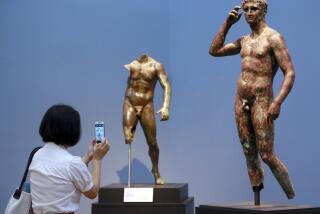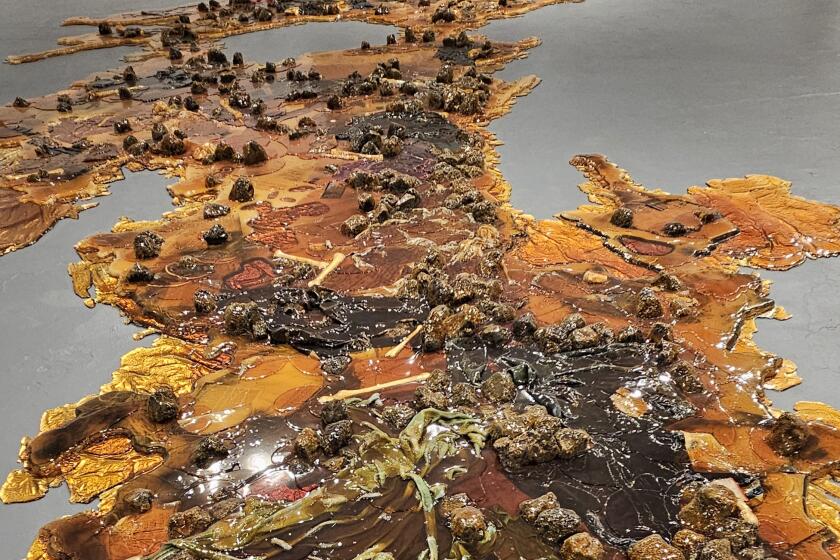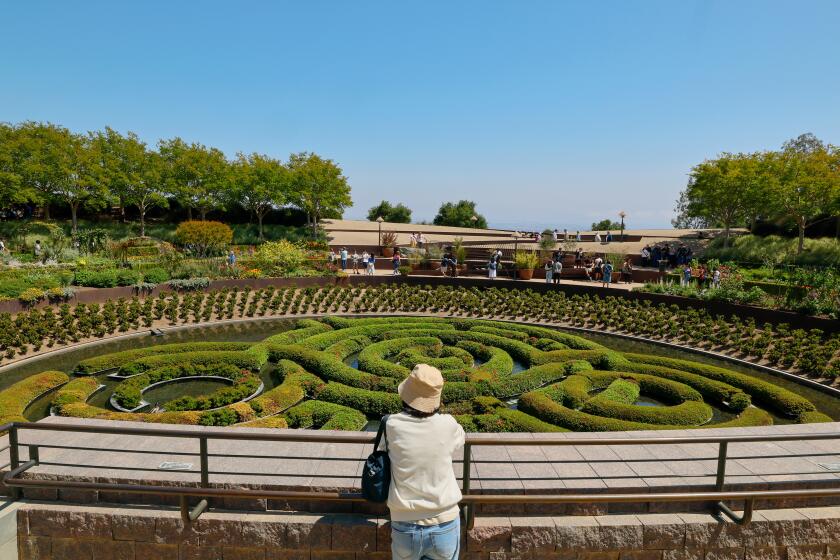Tut Rescue Not a Day Too Soon : Art: All the paintings in the tomb are damaged. The Getty’s joint restoration effort with Egypt will take at least four years.
Tutankhamen is an obscure historical figure, but he has been in the news for the past 70 years--ever since English archeologist Howard Carter stumbled across a stairway leading to the Egyptian boy king’s lavishly furnished tomb. This week’s story doesn’t concern a new round of Tut-o-mania or the funerary objects that have captured the public imagination, however. The news, announced on Wednesday in Cairo, is that the Getty Conservation Institute and the Egyptian Antiquities Organization have launched a sophisticated salvage effort on behalf of deteriorating paintings in the 3,300-year-old tomb.
The institute, currently based in Marina del Rey, will eventually be located at the Getty Center under construction in Brentwood, but its program has always been international. Sites of GCI’s ongoing projects include Tiwanaku, an ancient city in Bolivia, and the Mogao and Yungang rock grottoes in the People’s Republic of China.
Photographs of the Egyptian wall paintings indicate that the new project hasn’t come a day too soon. Cracked and peeling paint has removed large chunks of pigment from the dark hair of courtiers in a painting on the tomb’s east wall. All the paintings are stained, and they have a speckled appearance, resulting from widespread loss of pigment. In addition, black spots block out part of the imagery.
The dark patches, of undetermined origin, apparently predate the tomb’s discovery. Other problems are likely the results of the relatively recent effects of mass tourism, pollution and the elements. Whatever the causes of the damage, problems had become so acute that the Egyptian government last year closed the tomb, thereby losing a major tourist attraction.
Tutankhamen reigned for 10 years during Egypt’s 18th Dynasty. He died around 1323 BC, when he was about 19, and was buried in the Valley of the Kings near Luxor. The dazzling riches of his tomb--including about 5,000 pieces of regal jewelry, furniture and other accouterments for the king’s afterlife--are well represented at the Cairo Museum, and a sampling has been featured in blockbuster exhibitions, including a show in 1978 at the Los Angeles County Museum of Art.
These treasures have obscured the paintings, which cover walls of the tomb’s 13-by-21-foot burial chamber. But the vividly colored scenes and accompanying hieroglyphics provide invaluable evidence of ancient Egyptian life and artistic traditions. Mohamed Ibrahim Bakr, chairman of the Egyptian Antiquities Organization, calls the tomb paintings “a singular example of our country’s rich and extraordinary heritage.”
The paintings are executed in bright hues over a dull gold background on all four walls surrounding the king’s human-shaped gold coffin, which holds his mummy. The painting on the north wall is of greatest interest to scholars because it documents a historic event and departs from the portrayals of afterlife generally found in tombs. On the far right of this panel, the king’s successor, Ay, clad in a leopard’s skin, performs a mortuary ritual on the king’s mummy. The ceremony is said to have legitimized Ay’s unfounded claim to the throne. Two other scenes on the same wall depict Tutankhamen being received by the sky goddess Nut and being embraced by Osiris, who welcomes him to the underworld.
The east wall painting is also unusual because it portrays the young king’s funeral procession. More conventional paintings on the south and west walls depict scenes of Tutankhamen’s afterlife. On the south panel, he is pictured with Anubis, the jackal-headed god of embalming, and Hathor, goddess of the West. The west wall painting, divided into four horizontal strips, depicts a boat that takes the sun on its nightly journey, a procession of deities and a series of spirits in the form of baboons. This panel, similar to those found in other tombs, has been taken from “The Book of What Is in the Netherworld.”
According to plans revealed Wednesday, painting conservators Paolo and Laura Mora of Rome will head an international team in a three-phase effort to restore and preserve the paintings. During the preliminary 18-month period, specialists will diagnose problems, test methods of treatment and formulate a plan of conservation. Conservators--predominantly Egyptians--will carry out the plan during the second phase, which is expected to take at least two years. The final step is to set up a monitoring and maintenance system, and to establish guidelines for visitor access.
In addition to saving the paintings, the project is intended to provide Egyptian conservators with training and experience that can be applied to the preservation of other ancient sites in the region, according to Miguel Angel Corzo, director of the Getty Conservation Institute. “This, perhaps, is the most valuable contribution we can make to the long-term welfare of Egypt’s cultural treasures,” Corzo said in a prepared statement.
This is the Getty’s second major project in collaboration with the Egyptian Antiquities Organization. Four months ago, the two organizations completed the restoration of more extensive wall paintings in the tomb of Nefertari, favorite wife of Rameses II, in the nearby Valley of the Queens. One chamber of that elaborately decorated tomb will be re-created in an exhibition about the landmark project, opening on Nov. 12 at the J. Paul Getty Museum in Malibu.
More to Read
The biggest entertainment stories
Get our big stories about Hollywood, film, television, music, arts, culture and more right in your inbox as soon as they publish.
You may occasionally receive promotional content from the Los Angeles Times.






